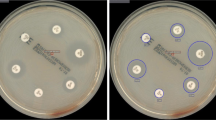Abstract
This study was performed to evaluate EUCAST blood culture (BC) rapid antimicrobial susceptibility testing (RAST) for Gram-negative organisms. Clinical BCs positive with Gram-negative-bacilli between April 23, 2019 and June 21, 2019, and 41 spiked isolates were tested by RAST against ceftazidime, piperacillin-tazobactam, meropenem, ciprofloxacin, gentamicin, and amikacin and compared against the routine method, Vitek 2. Vitek turnaround time was also audited. A total of 194 isolates were included, of which 68 Escherichia coli, 47 Klebsiella pneumoniae, and 33 Pseudomonas aeruginosa were further analyzed. For those with interpretable results, using CLSI M52 defined cutoffs for equivalence in antimicrobial susceptibility testing (VME ≤ 1.5%, ME ≤ 3.0%, CA ≥ 90%), RAST was considered equivalent to Vitek 2 for all reading times for the following drug-bug combinations: E. coli (meropenem, gentamicin, and amikacin); K. pneumoniae (ceftazidime, ciprofloxacin, and gentamicin); and P. aeruginosa (gentamicin). The highest error rates were MEs in piperacillin-tazobactam for E. coli at 4 h (5/9, 55.6%) and P. aeruginosa at 6 h (1/1, 100%). The number of MEs/VMEs for other drug-bug combinations and readings times ranged from 0 to 2 isolates (maximum of 7.7%). Median turnaround time to availability of Vitek results was 19.58 h for E. coli (IQR: 17.38–21.38 h), 19.43 h for K. pneumoniae (IQR: 17.72–20.67 h), and 23.3 h for P. aeruginosa (IQR: 21.32–24.35 h). Introduction of RAST shortens turnaround time to results. With the exception of piperacillin-tazobactam, the absolute number of errors was low. A larger-scale evaluation is required to confirm the suitability of implementing this testing method in local laboratories.
Similar content being viewed by others
References
Dubourg G, Lamy B, Ruimy R (2018) Rapid phenotypic methods to improve the diagnosis of bacterial bloodstream infections : meeting the challenge to reduce the time to result. Clin Microbiol Infect 24(9):935–943
Opota O, Croxatto A, Prod’hom G, Greub G (2015) Blood culture-based diagnosis of bacteraemia: state of the art. Clin Microbiol Infect 21(4):313–322
Mizrahi A, Amzalag J, Couzigou C, Péan De Ponfilly G, Pilmis B, Le Monnier A (2018) Clinical impact of rapid bacterial identification by MALDI-TOF MS combined with the bêta- LACTA ™ test on early antibiotic adaptation by an antimicrobial stewardship team in bloodstream infections. Infect Dis (Auckl) 50(9):668–677
Lutgring JD, Bittencourt C, Tekippe EM, Cavuoti D, Hollaway R, Burd EM (2018) Evaluation of the accelerate Pheno system : results from two academic medical centers. J Clin Microbiol 56(4):e01672–e01617
EUCAST (2019) Methodology-EUCAST rapid antimicrobial susceptibility testing ( RAST ) directly from positive blood culture bottles (Version 1.1)
Lee SY, Octavia S, Chew KL (2019) Detection of OXA-carbapenemase-producing-Enterobacteriaceae with chromID CARBA SMART® screening plate. Pathology 51(1):108–110
EUCAST (2019) Zone diameter breakpoints for rapid antimicrobial susceptibility testing ( RAST ) directly from blood culture bottles (Version 1.1)
(2017) M52 Verification of commercial microbial identification and antimicrobial susceptibility testing systems. Clinical and Laboratory Standards Institute
Poirel L, Potron A, Nordmann P (2012) OXA-48-like carbapenemases: the phantom menace. J Antimicrob Chemother 67(7):1597–1606
Banerjee R, Teng CB, Cunningham SA, Ihde SM, Steckelberg JM, Moriarty JP et al (2015) Randomized trial of rapid multiplex polymerase chain reaction – based blood culture identification and susceptibility testing. Clin Infect Dis 61(7):1071–1080
Thy M, Diep J, Krob S, Pe C, Couzigou C, Vidal B et al (2019) Clinical impact of rapid susceptibility testing on MHR-SIR directly from blood cultures. J Antimicrob Chemother 74:3063–3068
Pan H, Li W, Li R, Li Y, Zhang Y, Sun E (2018) Simple sample preparation method for direct microbial identification and susceptibility testing from positive blood cultures. Front Microbiol 9:481
Heather CS, Maley M (2018) Automated direct screening for resistance of gram-negative blood cultures using the BD Kiestra WorkCell. Eur J Clin Microbiol Infect Dis 37:117–125
Author information
Authors and Affiliations
Corresponding author
Ethics declarations
Conflict of interest
The authors declare that they have no conflicts of interest.
Ethics approval and informed consent
This was an in vitro study only. No specific ethical review and consent was required.
Additional information
Publisher’s note
Springer Nature remains neutral with regard to jurisdictional claims in published maps and institutional affiliations.
Rights and permissions
About this article
Cite this article
Soo, Y.T., Waled, S.N.M.B., Ng, S. et al. Evaluation of EUCAST rapid antimicrobial susceptibility testing (RAST) directly from blood culture bottles. Eur J Clin Microbiol Infect Dis 39, 993–998 (2020). https://doi.org/10.1007/s10096-020-03815-w
Received:
Accepted:
Published:
Issue Date:
DOI: https://doi.org/10.1007/s10096-020-03815-w




